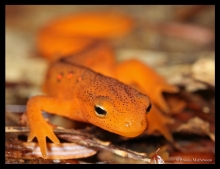You are here
Eastern Newt Dynamics at the Harvard Forest

As hemlock-dominated forests decline due to the invasive hemlock woolly adelgid (HWA), the abundance of red efts (the juvenile phase of the eastern newt) may also decline, reports a new study by Brooks Mathewson, a graduate of the Harvard Forest master's in forest science program.
Mathewson’s work - conducted across four seasons in all four major research tracts of the Harvard Forest - builds on earlier research that found eastern red-backed salamanders (Plethodon cinereus) to be more abundant in hemlock-dominated forests than in mixed deciduous stands (Mathewson 2009).
In visual encounter surveys along the forest floor, red efts tended to be twice as abundant in hemlock-dominated stands than in mixed deciduous stands. More intensive, quadrat-based studies showed that red efts were five times more abundant in hemlock-dominated stands than in mixed deciduous stands.
Mathewson's studies, conducted prior to the arrival of HWA at Harvard Forest, provide critical baseline data that can be used to directly assess potential changes in populations of salamanders as hemlock-dominated forests transition to mixed deciduous stands throughout New England.
- Read the scientific paper in Southeastern Naturalist: "The relative abundance of the juvenile phase of the eastern red-spotted newt at Harvard Forest prior to the arrival of hemlock wooly adelgid."
(Photo of red eft by Brooks Mathewson)

